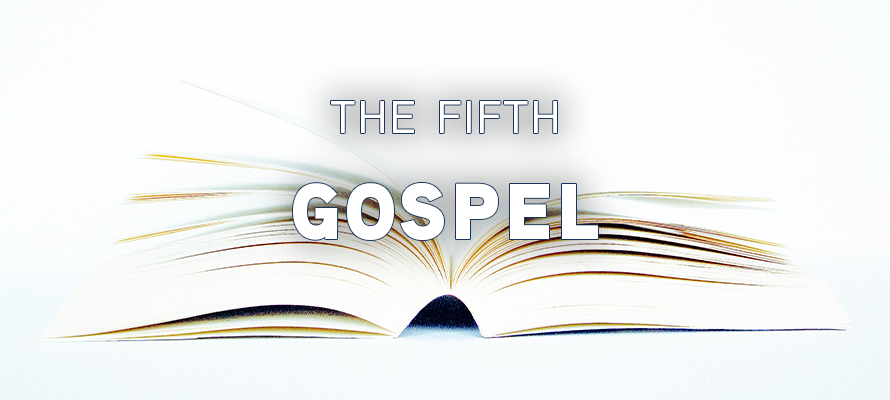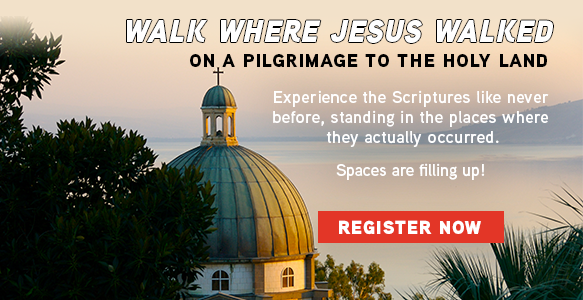
In his Apostolic Exhortation Verbum Domini (The Word of the Lord), Pope Benedict XVI writes:
The word of God and the Holy Land
89. As we call to mind the Word of God who became flesh in the womb of Mary of Nazareth, our heart now turns to the land where the mystery of our salvation was accomplished, and from which the word of God spread to the ends of the earth. By the power of the Holy Spirit, the Word became flesh in a specific time and place, in a strip of land on the edges of the Roman Empire. The more we appreciate the universality and the uniqueness of Christ’s person, the more we look with gratitude to that land where Jesus was born, where he lived and where he gave his life for us. The stones on which our Redeemer walked are still charged with his memory and continue to “cry out” the Good News. For this reason, the Synod Fathers recalled the felicitous phrase which speaks of the Holy Land as “the Fifth Gospel”.[307] How important it is that in those places there be Christian communities, notwithstanding any number of hardships! The Synod of Bishops expressed profound closeness to all those Christians who dwell in the land of Jesus and bear witness to their faith in the Risen One. Christians there are called to serve not only as “a beacon of faith for the universal Church, but also as a leaven of harmony, wisdom, and equilibrium in the life of a society which traditionally has been, and continues to be, pluralistic, multi-ethnic and multi-religious”.[308]
The Holy Land today remains a goal of pilgrimage for the Christian people, a place of prayer and penance, as was testified to in antiquity by authors like Saint Jerome.[309] The more we turn our eyes and our hearts to the earthly Jerusalem, the more will our yearning be kindled for the heavenly Jerusalem, the true goal of every pilgrimage, along with our eager desire that the name of Jesus, the one name which brings salvation, may be acknowledged by all (cf. Acts 4:12).
He is not the only one who refers to the Holy Land as “the Fifth Gospel,” however. A quote often attributed to Pope Paul VI (the first modern Pope to visit the Holy Land) says: The Holy Land is the fifth Gospel, which is not written on ink, but written on stones.
And another, commonly credited to St. Jerome in the 4th century: “Five gospels record the life of Jesus. Four you will find in books and the one you will find in the land they call Holy. Read the fifth gospel and the world of the four will open to you.”
Whether or not these words were spoken or written by these Saints, they do ring true in our modern world. Experiencing the Holy Land brings the Gospels of Matthew, Mark, Luke, and John into new light. Nearly all of our pilgrims who fill out our post-pilgrimage surveys share they will never hear or read the Bible the same after having experienced it in real life.
Reading just one page
To further flush out the metaphor of the fifth Gospel, if a pilgrim travels only to Israel, they are not “reading” the full story. The Holy Lands encompass more than just the modern country of Israel. Parts of modern Egypt, Syria, and Jordan all encompass sites mentioned or described in both the Old and New Testaments.
In Egypt, Moses received the ten commandments on Mt. Sinai after the Israelites escaped slavery during the Exodus. Jesus himself spent time here, fleeing the decree of Herod that resulted in the murder of the Holy Innocents. In Syria, the prophet Elijah took refuge from those wishing to kill him before his time. St. Paul was also converted on the road to Damascus, now the capital of Syria.
These two countries, however, are not safe pilgrimage sites at the moment, so today we would like to focus on Jordan – the country from which Moses viewed the Promised Land and where Jesus was baptized. Some of our Holy Land pilgrimages do include days in Jordan, and if you are intrigued to “read this page” of the Holy Land in person, we encourage you to check them out.
After the Israelites crossed the Red Sea, they wandered the desert for 40 days. This desert is now in Jordan. One of the most moving pilgrimage sites is this desert is Mt. Nebo. On this mountain, Moses stood and looked across the Jordan River upon the Promised Land. Though he himself was not permitted to cross into the Land due to his disobedience, he was granted the blessing of gazing upon it shortly before his death.
Petra is perhaps one of the most famous sites in Jordan, and is biblical, though not by its current name. Sela was an ancient Nabatean city mentioned in the Old Testament. It also lies in the land of the Edomites – the descendants of Esau, son of Isaac and brother of Jacob (Israel). Near Petra lies the burial place of Aaron, brother of Moses and first High Priest of the Israelites.
Machaerus houses the ruins of the fortress of Herod the Great. It was here where John the Baptist was imprisoned and later beheaded as a birthday gift at the request of Salome.
Bethany-beyond-the-Jordan is the site on the Jordan River considered to be the original location of the baptism of Jesus. It lies in the area where John the Baptist lived and preached and not too far from where he died. Elijah also ascended into heaven from this site, and it was from here Joshua led the Israelites across the river into Jericho.
Another Old Testament site, Tel Mar Elias, is the birthplace of the prophet Elijah. In addition, many of the ancient peoples referenced in the Old Testament resided in what is now Jordan.
Jordan is a rich land full of historical and spiritual significance. Participating in a pilgrimage that includes both Israel and Jordan will help you to experience the fullness of the Holy Land. We invite you to consider one of our upcoming pilgrimages featuring both of these fascinating areas.




